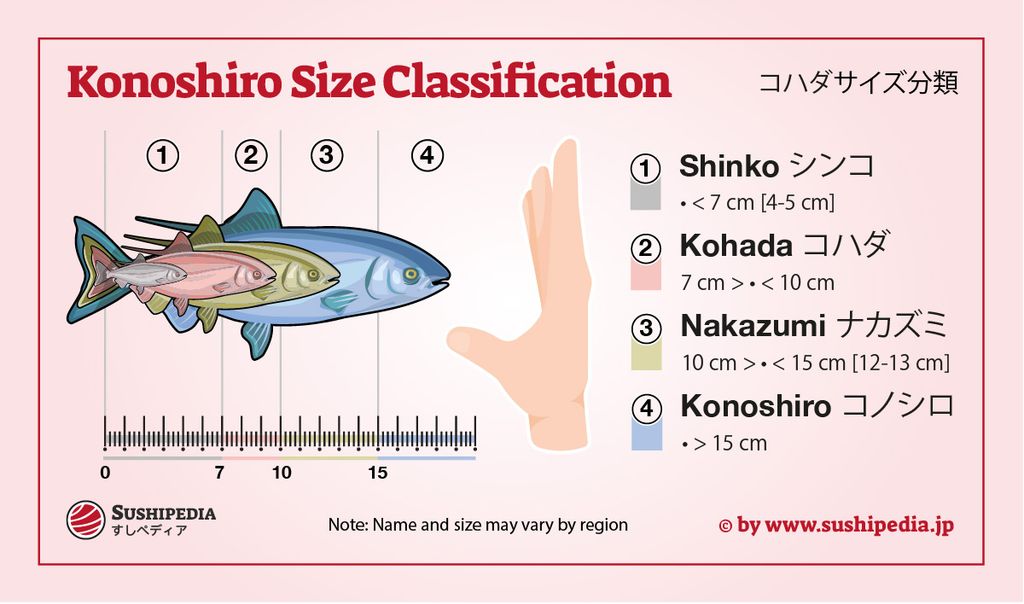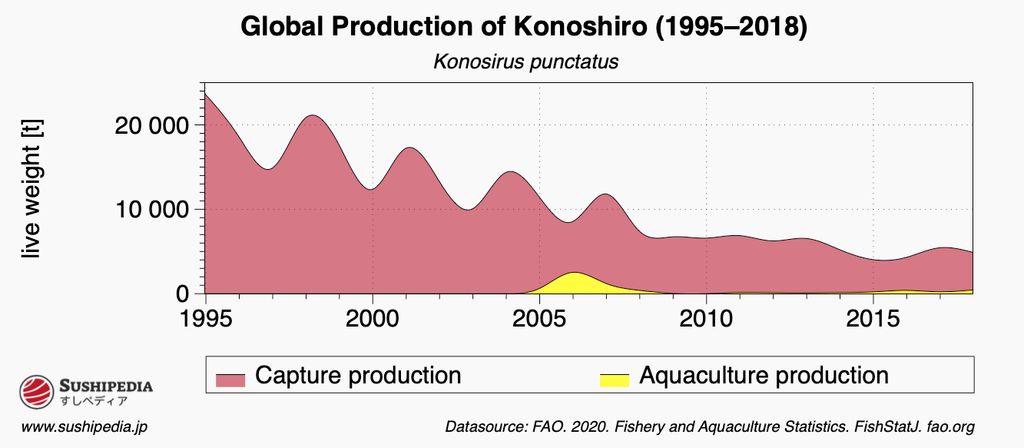Konoshiro Sushi
A Comprehensive Overview of Dotted Gizzard Shad in Japanese Sushi Cuisine
コノシロすし 、 鰶寿司 
What is Konoshiro / Kohada?
Konoshiro, scientifically known as Konosirus punctatus, is a medium-sized spotted Pacific herring that is mainly found in the coastal waters of the western Pacific. Medium-sized specimens, referred to as kohada, are predominantly preferred for sushi. The small to medium-sized fish, which is characterized by its shiny silvery skin and the dark, dot-shaped markings on its body, plays an important role in Japanese cuisine, particularly in the preparation of sushi.
Konoshiro or kohada is highly prized for its distinct taste qualities, which are characterized by a fine blend of fattiness and a hint of bitterness. It is considered one of the classic representatives of “blue-backed fish” as well as the “shiny fish” for traditional sushi. Preparing the fish requires skill and knowledge, as boning, marinating and the visually appealing presentation of the fish are important.
Konoshiro for Sushi or Sashimi
The meat with its characteristic skin is not only a popular ingredient for the preparation of sushi or sashimi, it is also a symbol for the philosophy of edomae sushi among connoisseurs and chefs alike. Because of its fresh, shiny appearance, it is considered one of the most beautiful sushi dishes, which reaches its peak in flavor only when properly prepared and combined with sushi rice.
Kohada is the cheapest fish among all sushi neta (sushi ingredients, typically fish), but if you prep it well, it turns into the “Yokozuna of Nigiri”.
Jiro Ono, Sushi Chef (Sukiyabashi Jiro), Satomi 2016
When the meat of konoshiro is salted and marinated in vinegar, an exceptionally full-bodied taste is created, which harmonizes wonderfully with the subtle sweetness of sushi rice. In addition, the marinating process reduces the strong taste and softens any bones that may still be present. The duration of application and dosage of salt and vinegar are adjusted according to the size of the fish, the amount of fat and the season, so that a lot of experience in preparation is required. It is said that hardly any other fish can vary so much in taste by treatment with salt and vinegar. Therefore, it is said that konoshiro or kohada is a measure of the skill of the chef or the quality of a sushi restaurant, as the taste changes significantly depending on the amount of vinegar and salt used. Depending on the size of the fish, either the whole fish can be used or up to four whole specimens of smaller size.
The taste of kohada sushi is characterized by mineral aromas accompanied by a buttery sweetness and subtle acidity. The range of possible side dishes or garnishes is wide and extends from an extraordinarily fine preparation of egg yolk or shrimp paste to yuzu citrus fruit and an individually refined seasoning sauce. The sauce is often applied as a thin glaze to the fish before it is served as nigiri sushi. Besides its wonderful rich and fatty taste, the meat is rich in proteins, essential fatty acids and trace elements.
Best Season
The spawning season begins in early spring and ends in early summer, with some fish spawning twice or more.[1] The season for small fish named shinko starts in July and ends in August. Medium-sized specimens with the name kohada are mostly caught between August and September. Large specimens of the konoshiro are caught all year round, but are most palatable in the winter period from November to February.
Konoshiro in Japan
A fish that changes its name
Konoshiro belongs in Japan to the “rising or ascending fishes”, this refers to fishes that change their name depending on size and age. A dotted gizzard shad carries the name shinko up to about 5 cm total length, from a size of 7 to 10 cm it is called kohada. As soon as it reaches 13 cm, it carries the name nakazumi, in order to then be called konoshiro as adult fish from a length of 15 cm. For the preparation of a nigiri sushi, depending on the size of the fish, either whole or multiple specimens of the size shinko are used. Large specimens are rarely used for the preparation of sushi or sashimi, but are suitable for other types of preparation.

SushiPedia. Konoshiro Size Classification for Sushi. All rights reserved ©
If you look at the growth in value of the konoshiro, you can almost mockingly claim that it is a “descending fish”, because with increasing size its value and thus its selling price decreases. Especially for the preparation of sushi, smaller sizes like kohada or shinko are appreciated.
Characteristics & Ecology of Konoshiro
The distribution area extends along the coast of the Japanese archipelago over the Korean peninsula to the East China Sea. The dotted gizzard shad is only slightly migratory and does not change its habitat significantly during its life cycle. Its diet consists mainly of plankton, diatoms and small crustaceans.
Economy of Konoshiro

SushiPedia. Global Catch Volumes of Konoshiro – Fisheries Statistics · Sushipedia. All rights reserved ©
Konoshiro is only of minor economic importance. According to the Food and Agriculture Organization of the United Nations (FAO), Japan is the only country that catches it in industrially relevant quantities. Since 2005, South Korea has been producing konoshiro from aquaculture.[2]
Season Calendar for Konoshiro
The calendar shown does not provide information on fishing times, but marks the periods in which konoshiro is considered particularly tasty.
Warnings related to Konoshiro
Video about Konoshiro Sushi
External video embedded from: youTube.com. Credit Ginza Watari. How to Make Gizzard Shad (Kohada) Nigiri【English subtitles】.
Species of Konoshiro
The following species are regarded as authentic konoshiro. Either historically, according to the area of distribution or according to the common practice in today's gastronomy:
Sources and Further Reading
- [1]Toru Takita. Reproductive Ecology of a Shad, Konosirus punctatus in Ariake Sound―I Distribution, Body Condition, and Maturation (有明海産コノシロの増殖生態-1 : 分布と産卵群の魚体特性). Nagasaki University Faculty of Fisheries Research Report (長崎大学水産学部研究報告) 45 5-10. 1978
- [2]Fisheries and Aquaculture Department. Fishery and Aquaculture Statistics. Global production by production source 1950-2018 (FishstatJ). Food and Agriculture Organization of the United Nations (FAO), Rome. 2020. Source retrieved 12/24/2020
- [3]Fish and Fishery Products Hazards and Controls Guidance, Fourth Edition – June 2021. U.S. Department of Health and Human Services, Food and Drug Administration Center for Food Safety and Applied Nutrition. 2021
- [4]Seon Hee Choi, Jung Kim, Jin Ok Jo, Min Kyung Cho, Hak Sun Yu, Hee Jae Cha, Mee Sun Ock. Anisakis Simplex Larvae: Infection Status in Marine Fish and Cephalopods Purchased from the Cooperative Fish Market in Busan, Korea. Korean Journal of Parasitology 49 (1) 39-44. 2011
- Shinzo Satomi. Sukiyabashi Jiro. Vertical Inc., New York. 2016
- 『コノシロ(子代)/シンコ(新子)/コハダ(小鰭):旬の魚介百科 (Konoshiro, Shinko, Kohada: Encyclopedia of Seasonal Seafood)』. FoodsLink フーズリンク、旬の食材百科辞典、 2020. Source retrieved 1/18/2022
- IUCN Red List of Threatened Species. Version 2023-1
Image Credits
- SushiPedia. Global Catch Volumes of Konoshiro – Fisheries Statistics · Sushipedia. All rights reserved ©
- SushiPedia. kohada. All rights reserved ©
- SushiPedia. Konoshiro Size Classification for Sushi. All rights reserved ©